As a devoted dog owner, you want to ensure your beloved canine companion lives a happy and healthy life. This often means carefully managing their diet, but with so many human foods around, it can be challenging to know what food is bad for puppies and what’s safe. While some human foods are perfectly fine and even beneficial for dogs, many common household items can be incredibly dangerous, even toxic, in small amounts. Each year, over 401,500 pet poisonings occur in the United States, with common foods being a significant contributor. Understanding what food dogs can’t eat is crucial to prevent these incidents and keep your furry friend safe. This guide will serve as your essential resource, detailing foods to avoid and why, alongside safe alternatives.
Why Certain Foods Are Toxic to Dogs
The question of “what can dogs eat and not eat?” stems from fundamental physiological differences between humans and canines. Dogs’ digestive systems and metabolisms are distinct from ours, meaning they process certain substances very differently. For instance, dogs metabolize the theobromine and caffeine found in chocolate much slower than humans, allowing these compounds to build up rapidly in their system and potentially become fatal. Similarly, while you might enjoy cherries, the cyanide in their pits, stems, and leaves can pose a problem if ingested in large quantities by your dog. Moreover, fruit pits can cause digestive upset and blockages.
Food toxicity can also vary significantly based on a dog’s size, breed, and existing health conditions. A small amount of a toxic food might be harmless to a large breed but life-threatening to a smaller dog. Therefore, if you ever have questions or concerns about foods your dog shouldn’t eat, always consult your veterinarian.
List of Common Foods Dogs Cannot Eat
Many everyday household foods are dangerous, and often toxic, to dogs. While this list covers the most common culprits, it is not exhaustive. Always err on the side of caution.
1. Alcohol
Due to their smaller size, alcohol can have a far deadlier effect on dogs than on humans. Even minimal amounts can cause significant harm, with the danger increasing for smaller pets. Symptoms of alcohol poisoning in dogs mirror those in people, including vomiting, breathing difficulties, coma, and even death.
2. Apple, Apricot, Cherry, and Plum Seeds/Pits
While the fleshy part of apples is safe for dogs, the core and seeds are not. Apple seeds contain cyanide, and though small amounts might not be immediately problematic, it’s best to remove the core and seeds entirely. Similarly, the seeds and pits of apricots, cherries, peaches, and plums must be avoided. These also contain cyanide, which can lead to vomiting, irregular and rapid heartbeats, seizures, coma, and even death by preventing red blood cells from effectively carrying oxygen.
3. Avocado
Avocados are generally not a good choice for dogs. While the direct toxicity in dogs is debated (two dogs in South Africa reportedly died from myocardial damage after eating avocados, though this hasn’t been widely replicated), avocados are known to cause issues in other mammal species. More critically, an intact avocado pit can cause a dangerous gastrointestinal obstruction if swallowed by a dog, making it safest to avoid this food altogether.
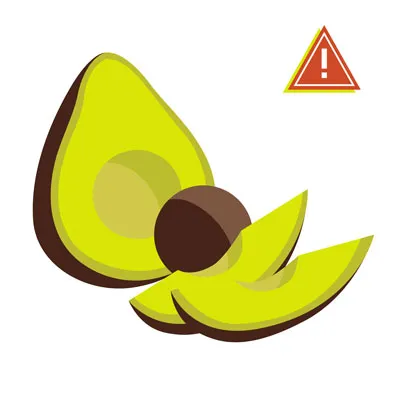 Avocado
Avocado
4. Broccoli
Broccoli contains isothiocyanates, which can be harmful to pets in very large doses. While small, occasional amounts might be acceptable, it’s generally best to avoid them given the abundance of other healthy and safe vegetables available for dogs. Additionally, broccoli stalks can pose a choking hazard or cause an obstruction in a dog’s throat.
5. Caffeine and Coffee Grounds
Caffeine, including that found in coffee grounds, contains methylxanthines. These compounds can cause severe, potentially fatal symptoms such as diarrhea, vomiting, seizures, and irregular heartbeats. Ingesting coffee grounds or high-caffeine drinks can lead to a racing heart, tremors, arrhythmia, and difficulty breathing, among other serious symptoms.
6. Chicken & Turkey Skin, Ham, & Other Fatty Cuts of Meat
Fatty cuts of meat, including ham and the skin from chicken or turkey, should be avoided as treats for pets. Their high-fat content can trigger acute pancreatitis, a severe and life-threatening illness with serious complications. It’s also crucial to avoid giving dogs turkey and chicken bones, as they can splinter, causing internal damage, obstructions, or even punctures to the stomach or intestines, potentially leading to fatal abdominal infections.
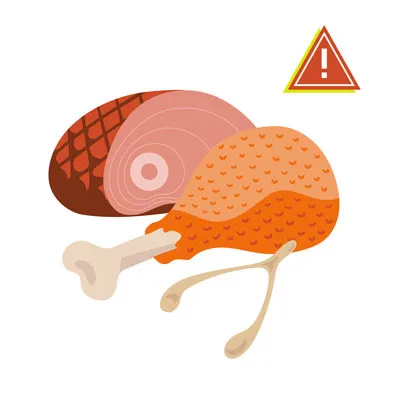 Chicken & Turkey Skin, Ham, & Other Fatty Cuts of Meat
Chicken & Turkey Skin, Ham, & Other Fatty Cuts of Meat
7. Chocolate
Chocolate toxicity is a frequent cause of pet poisoning, especially during holidays. Dogs absolutely cannot eat any chocolate product. Chocolate contains theobromine, a compound toxic to dogs, with darker chocolates containing higher concentrations. It also contains caffeine, and some sugar-free chocolates may contain xylitol, another highly toxic substance for dogs. Dogs and cats cannot metabolize chocolate as effectively as humans. While dark and baker’s chocolate are the most dangerous, any type of chocolate can be problematic. Symptoms of chocolate ingestion include hyperactivity, vomiting, diarrhea, pancreatitis, abnormal heart rhythm, and seizures. If your dog consumes any amount of chocolate, contact your veterinarian immediately.
8. Grapes and Raisins
Grapes and raisins are exceptionally dangerous for dogs. These fruits can lead to severe kidney failure because their tartaric acid is toxic to canine kidneys. Even a small number of grapes or raisins can cause significant harm. Symptoms of grape or raisin poisoning include vomiting, diarrhea, loss of appetite, changes in urination (either increased or no urination), and lethargy.
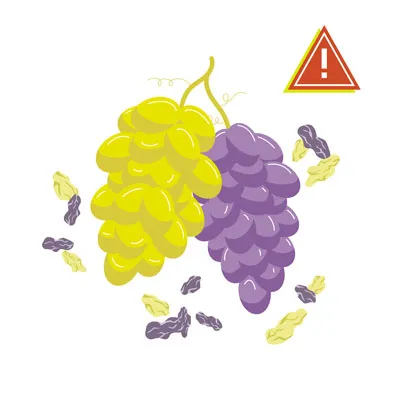 Grapes & Raisins
Grapes & Raisins
9. Macadamia Nuts, Almonds, and Pistachios
Macadamia nuts are particularly toxic to dogs, causing painful symptoms such as weakness, overheating, and vomiting. The exact mechanism of toxicity isn’t fully understood, but even as few as six nuts can cause severe poisoning in a small dog. Other nuts, like pistachios and almonds, are primarily concerns due to being potential choking hazards or if they are flavored or spiced, which can introduce other harmful ingredients.
10. Milk and Dairy Products
The suitability of milk and other dairy products varies among dogs. Some dogs can consume them without issue, while others are lactose intolerant or allergic, experiencing diarrhea and gas after consuming cow’s milk. Ice cream is also unhealthy due to its high sugar and fat content. Instead, consider freezing small pieces of safe fruits as a treat. Cheese, in small quantities, can be acceptable, but opt for lower-fat varieties as treats.
11. Mushrooms
It is always best to avoid feeding mushrooms to your dog, erring on the side of caution. Wild mushrooms can contain a variety of toxins that may lead to kidney and liver failure, vomiting, diarrhea, hallucinations, and damage to red blood cells. While washed, white mushrooms from a grocery store might be okay, choosing a different, unequivocally safe treat is a much safer option.
12. Nutmeg and Cinnamon
Dogs should never be given foods containing nutmeg. This spice contains myristicin, which can cause hallucinations and severe vomiting, especially in high doses or when consumed by smaller dogs. If your dog ingests any amount of nutmeg, contact your veterinarian for guidance. Cinnamon, while not toxic, can irritate your dog’s mouth and, in some cases, lead to low blood sugar, which can have serious health consequences.
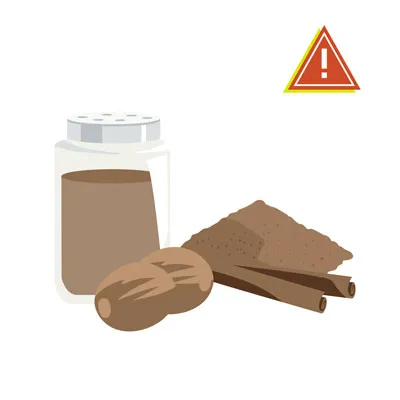 Nutmeg & Cinnamon
Nutmeg & Cinnamon
13. Onions, Garlic, Chives, and Leeks
Many pet owners are unaware that herbs from the allium family, including onions, garlic, chives, and leeks, are unsafe for dogs. These plants contain sulfoxides and disulfides, which can damage red blood cells and lead to anemia in both dogs and cats. Onion and garlic powders are common in many prepared human foods, even baby food, so carefully read labels before sharing any store-bought items with your pet. All allium plants can cause potentially fatal anemia in dogs and cats, with certain Japanese breeds like Akitas and Shiba Inus being particularly sensitive.
14. Salt
Excessive amounts of salt can disrupt the fluid balance in a dog’s cells. Too much salt can cause tremors, seizures, diarrhea, or even a coma. Whether your dog is interested in rock salt, homemade playdough, or potato chips, do not let their pleading eyes compromise their health.
15. Spicy Food
Keep your dog away from spicy foods. Hot, spicy ingredients can cause vomiting, stomach ulcers, or diarrhea, leading to considerable discomfort for your dog and potentially costly emergency veterinary visits.
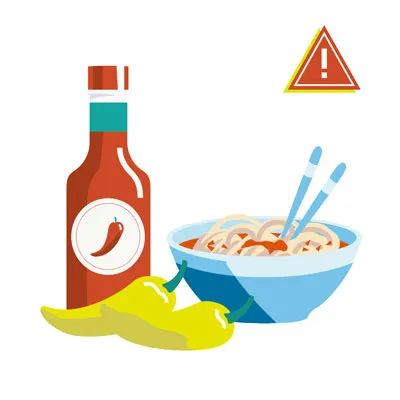 Spicy Food
Spicy Food
16. Sugar-Free Gum and Candy (Xylitol)
Xylitol is an artificial sweetener found in numerous human foods, including sugar-free gum, candy, and many sugar-free baked goods. In dogs, it causes a rapid and dangerous drop in blood sugar, leading to weakness and seizures. Some dogs may also develop liver failure. Cases of xylitol poisoning in dogs are increasing. The amount of xylitol in just five pieces of gum could potentially be fatal for a 65-pound dog.
17. Tomatoes and Raw Potatoes
Tomatoes and potatoes fall into a category of foods that are safe in some forms but unsafe in others. A ripened red tomato is generally acceptable. However, the green parts of the tomato plant and unripe green tomatoes contain solanine, which is toxic to dogs. Potatoes follow a similar pattern: baked or boiled potatoes without additives are generally safe in small amounts, but raw potatoes also contain solanine and are toxic.
18. Tobacco
Tobacco and nicotine-containing products are extremely dangerous and unhealthy for dogs. Exposure can cause a range of symptoms, including vomiting, diarrhea, rapid or labored breathing, agitation, abnormal heart rate, wobbliness, muscle weakness, high or low blood pressure, seizures, and tremors. More significant or frequent exposure can lead to blue gums, coma, and ultimately be fatal. Dogs’ curious nature means they might find discarded cigarettes or butts. If your dog ingests any tobacco, immediate veterinary attention is critical.
19. Yeast and Raw Dough
Yeast and raw dough are unsafe for dogs for multiple reasons. The raw dough can expand significantly in a dog’s stomach, causing severe pain and potentially life-threatening conditions like torsion or rupture of the stomach. Furthermore, the yeast and sugar in raw dough can ferment, producing alcohol and leading to alcohol toxicity. This is a critical emergency requiring immediate medical intervention.
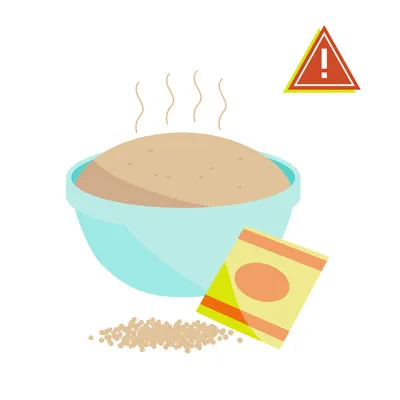 Yeast & Raw Dough
Yeast & Raw Dough
20. Raw Meat
You should never feed your dog raw or undercooked meat. Raw meat can harbor harmful bacteria such as Salmonella or E. coli, which can sicken dogs just as they can sicken humans. Additionally, bones in raw meat can pose a choking hazard or cause internal injuries.
21. Rhubarb
Rhubarb, often used in desserts, is not safe for pets. Its leaves contain soluble calcium oxalate crystals. Ingested in large enough quantities, these crystals can bind with calcium in the dog’s body, causing a dangerous drop in calcium levels and potentially leading to renal failure. Symptoms include tremors, weakness, drooling, bloody urine, changes in thirst and urination, and vomiting.
22. Star Fruit
Similar to rhubarb, star fruit also contains soluble calcium oxalate crystals. Do not allow your dog to consume this fruit.
23. Flavored and Seltzer Water
Always opt for fresh, clean water for your dog over anything flavored or carbonated. Flavored and seltzer waters can contain added ingredients like sugar or salt that are dangerous for pups. While plain seltzer water might be acceptable in very small, urgent situations, it can cause gas and bloating. Plain water is always the safest and best choice.
Safe Foods Your Dog Can Eat
While the list of foods to avoid is extensive, there are also many what can dogs eat and drink that are perfectly safe and healthy for dogs. These can be excellent alternatives for treats or supplements to their regular diet. Some of the safest and most enjoyed human foods by dogs include apples (without the core), green beans, and carrots.
Here are some popular foods that are safe for your dog:
1. Apples, Oranges, and Bananas
The fleshy parts of apples, without the core and seeds, are perfectly fine for dogs. Always cut off a small piece to ensure no seeds are present. Oranges are safe in small quantities. Bananas, peeled and in moderation, can also be a tasty treat.
2. Blueberries and Blackberries
Blueberries are delicious and healthy treats many dogs love. They are packed with antioxidants, fiber, phytochemicals, and vitamin C, all beneficial for your pup’s health.
3. Cantaloupe, Mango, Peaches, Pears, Pineapples, and Watermelons
Many fruits can be safely enjoyed by your dog. Cantaloupes are a great option. Watermelon, with rinds and seeds removed (including the pale seeds in seedless varieties to prevent choking), is particularly refreshing on a warm day due to its high water content. Mangoes, peaches, pears, and pineapples are also safe in moderation, provided the seeds, pits, and cores are removed.
4. Carrots, Cucumber, and Celery
When seeking safe vegetable options, remember the “three C’s”: carrots, cucumbers, and celery. These are particularly good for overweight dogs due to their low-calorie content. Bite-sized carrot pieces offer a satisfying crunch, and celery can even help with bad breath. Cucumber slices provide vitamins and minerals with minimal carbohydrates or fats. You might also be interested in what is good for dogs to eat human food.
5. Cheese
While dairy products like milk should generally be limited, a small amount of cheese occasionally is acceptable if your dog is not lactose intolerant. Always choose lower-fat varieties, such as a small piece of mozzarella, as high-fat cheeses can be dangerous.
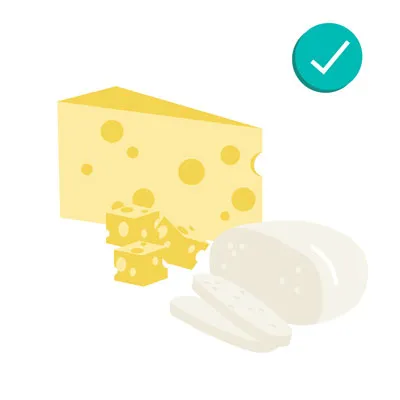 Cheese
Cheese
6. Eggs
Fully cooked eggs are a tasty and beneficial treat. Scrambled eggs can even help soothe an upset stomach and provide an excellent source of protein.
7. Peanuts, Peanut Butter, and Cashews
Peanuts and cashews are safe for dogs in small quantities. Due to their high-fat content, offer them sparingly and ensure they are unsalted, unflavored, and unspiced. Peanut butter, in moderation, is a high-protein treat. Always choose unsalted, natural peanut butter and strictly avoid any sugar-free varieties containing xylitol. This can also help you determine what should you feed a dog.
8. Popcorn and Corn
Air-popped, unsalted, and unbuttered popcorn can be a treat your dog enjoys. Ensure all unpopped kernels are removed to prevent choking. Similarly, corn (removed from the cob) is acceptable when served plain, without butter, salt, or spices.
9. Coconut and Honey
Small amounts of coconut, including coconut milk and coconut oil, are generally fine for dogs. Coconut contains lauric acid and may even help with allergies. However, some dogs might experience an upset stomach from fresh coconut or coconut milk, so introduce it cautiously. Avoid coconut water as it’s not safe. Also, ensure your dog doesn’t chew on the furry shell, which can be a choking hazard. Honey, in moderation, is safe and provides numerous vitamins and minerals.
10. Shrimp and Fish
Plain, fully cooked shrimp is a great choice for dogs. Remember to remove the shell, head, tail, and legs, and avoid any seasoned, salted, or buttered preparations. Fish, especially salmon and sardines, is also permissible. Ensure it’s plain, fully cooked, and boneless. A general guideline is to offer fish no more than twice a week. Plain, canned tuna, packed in water (not oil), is safe in moderation to avoid excessive mercury and salt.
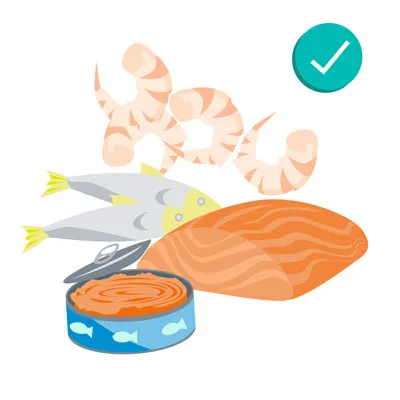 Shrimp and Fish
Shrimp and Fish
11. Turkey
Turkey meat, with the skin, fat, and bones removed, is a healthy and safe source of protein for dogs. Offer small bites of plain turkey as a delicious treat, avoiding any seasoned or salted varieties. This also applies to what is the one meat that dogs should never eat.
12. Grains, Wheat, and Quinoa
A small amount of wheat or other grains is generally fine for dogs, similar to corn. Quinoa is a healthier filler option. Always monitor your dog for any signs of allergic reactions when introducing new grains.
13. Green Beans
Many dogs enjoy green beans, whether raw, steamed, or from a can. They are safe, tasty, and healthy. Choose raw or plain cooked green beans without added spices, oils, or salt, and cut them into small pieces to prevent choking.
What Dogs Are Most at Risk if They Consume Toxic Foods?
While all dogs should be protected from toxic foods, certain factors can increase a dog’s risk if exposure occurs:
- Small breeds vs. large breeds: Smaller dogs are more vulnerable to toxic substances, like chocolate, due to their lower body weight.
- Puppies: Younger dogs have less developed digestive and immune systems, making them more susceptible to certain substances.
- Elderly dogs: Older dogs may face higher risks due to pre-existing health conditions.
- Dogs with pre-existing conditions: Conditions such as diabetes or kidney disease can significantly increase a dog’s risk from consuming toxic foods.
How To Prevent Dogs from Eating Toxic Foods
While accidents can happen, proactive measures can greatly minimize the risk of your dog ingesting unsafe human foods.
1. Store Foods Out of Reach
Ensure all toxic foods are inaccessible to your dog. Keep dangerous items on high shelves or securely locked away in cabinets that your pup cannot open.
2. Avoid Feeding Dogs from Your Plate
Resist the urge to feed your dog from your plate or while you’re cooking in the kitchen, even if it’s just a small treat. It’s safest to only give your dog treats specifically formulated for them.
3. Educate Family Members and Guests
Inform all family members, including children, and guests about the importance of not sneaking food to your dog, no matter how tempting it may be.
4. Be Careful During Holidays
Exercise extra caution during holidays when busy environments and abundant food can make it easy to let your guard down. If, despite your precautions, your dog eats something toxic, be prepared to act quickly. Keep contact information for emergency veterinarians (available 24/7) and poison control readily accessible.
What To Do if Your Dog Eats Something Toxic
If you suspect your dog has eaten toxic food, seek help as quickly as possible. Familiarize yourself with the common symptoms of food toxicity, which can include listlessness, distress, pain, vomiting, bloody stools, or a bloated and hard stomach (which can indicate a life-threatening condition).
If you observe these symptoms, do the following:
- Call your veterinarian or poison control immediately. Time is critical for successful treatment and shorter hospitalization.
- Be prepared with essential information: The type of food eaten, the estimated amount consumed, and the time of ingestion.
- Avoid home remedies unless advised by your veterinarian. Treatments vary depending on the toxin, and even inducing vomiting can be harmful in some cases.
Pets Best Can Help You Keep Your Dog Healthy
Navigating the world of household toxins and dangerous foods can be challenging, especially since dogs don’t always have discerning tastes. However, by following this comprehensive guide and remaining vigilant, you can significantly protect your dog from harmful foods.
Fortunately, there’s a wide array of safe and healthy foods your dog can enjoy! Discover which ones on our safe list your dog loves and offer them as rewarding treats. If you are ever unsure about any food, always consult your veterinarian. Pet insurance can also provide peace of mind for unexpected encounters with toxins. Many plans offer access to a 24/7 Pet Helpline, where you can speak to a veterinary expert anytime, which can be invaluable if you’re concerned about something your pet may have eaten.
References
- “Top 10 dog poisons,” Hilary Parker (5/2023), WebMD, https://www.webmd.com/pets/dogs/top-10-dog-poisons
- “What happens if a dog eats chocolate?” (10/2023), Colorado State University, https://vetmedbiosci.colostate.edu/vth/animal-health/why-is-chocolate-bad-for-dogs/
- “Fruits and vegetables dogs can or can’t eat,” (3/2024), American Kennel Club, https://www.akc.org/expert-advice/nutrition/fruits-vegetables-dogs-can-and-cant-eat/
- “What to do if your dog drinks alcohol,” Jerry Klein (7/2023), American Kennel Club, https://www.akc.org/expert-advice/vets-corner/is-alcohol-dangerous-for-dogs/
- “Can dogs eat apples?” Hector Joy (12/2022), PetMD, https://www.petmd.com/dog/general-health/can-dogs-eat-apples
- “Can dogs eat plums?” Katie Koschalk (7/2023), Chewy, https://be.chewy.com/nutrition-pet-diet-tips-can-dogs-eat-plums/
- “Avocado (Persea spp) Toxicosis in Animals,” Cristine Hayes (9/2024), Merck Veterinary Manual, https://www.merckvetmanual.com/toxicology/food-hazards/avocado-persea-spp-toxicosis-in-animals
- “People foods to avoid feeding your pets,” (n.d.), ASPCA, https://www.aspca.org/pet-care/animal-poison-control/people-foods-avoid-feeding-your-pets
- “People foods dogs can and can’t eat,” (3/2024), American Kennel Club, https://www.akc.org/expert-advice/nutrition/human-foods-dogs-can-and-cant-eat/
- “Can dogs eat nuts?” Amanda Ardente (1/2023), PetMD, https://www.petmd.com/dog/nutrition/can-dogs-eat-nuts
- “Can dogs drink milk?” Sandra C. Mitchell (1/2024), PetMD, https://www.petmd.com/dog/nutrition/can-dogs-drink-milk
- “Can dogs have nutmeg?” Barri J. Morrison (11/2023), PetMD, https://www.petmd.com/nutmeg-safe-dogs
- “Onion, garlic, chive, and leek poisoning in dogs,” Renee Schmid et al. (2024), VCA Animal Hospitals, https://vcahospitals.com/know-your-pet/onion-garlic-chive-and-leek-toxicity-in-dogs
- “Can dogs eat tomatoes?” Anna Burke (10/2024), American Kennel Club, https://www.akc.org/expert-advice/nutrition/can-dogs-eat-tomatoes/
- “Can dogs eat potatoes?” Katherine Ripley (11/2023), American Kennel Club, https://www.akc.org/expert-advice/nutrition/can-dogs-eat-potatoes/
- “What to do if your dog eats a cigarette butt,” (6/2023), American Kennel Club, https://www.akc.org/expert-advice/health/dog-ate-cigarette-butt/
- “Dough & dogs: Why it’s bad and what you can do,” Lisa Goldstein (7/2024), Preventive Vet, https://www.preventivevet.com/dogs/dough-is-toxic-to-dogs
- “Rhubarb,” (n.d.), Pet Poison Helpline, https://www.petpoisonhelpline.com/poison/rhubarb/
- “Can dogs drink carbonated water?” Heather Logue (n.d.), Rover, https://www.rover.com/blog/can-dogs-drink-carbonated-water/
- “What fruits can dogs eat?” Ellen Malmanger (2/2024), PetMD, https://www.petmd.com/dog/nutrition/what-fruits-can-dogs-eat
- “Can dogs have green beans?” Anna Burke (8/2022), American Kennel Club, https://www.akc.org/expert-advice/nutrition/can-dogs-have-green-beans/
- “About pet food safety,” (4/2024), CDC, https://www.cdc.gov/healthy-pets/about/pet-food-safety.html
